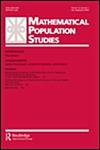意大利各省每日新冠肺炎感染人口密度遵循泰勒定律
IF 1.3
3区 社会学
Q3 DEMOGRAPHY
引用次数: 0
摘要
摘要泰勒定律指出,人口密度的空间方差是平均人口密度的幂函数。这项法律在2020年2月25日至2021年3月15日的五个时间段内对每日新冠肺炎感染密度进行测试。意大利各省按地理位置分为三个部分。联立方程模型解释了系综之间的相关性、每个系综内意大利省份之间的相关性以及时间自相关。所选时期的总体泰勒定律斜率均低于2(反映国家层面的干预措施),或全部高于2(反映地方层面的干预行动),或一些总体高于2,而另一些总体低于2。泰勒定律斜率和平均密度趋势表明感染密度是高度集中在少数省份(当斜率随着密度的增加而大于2时,当斜率随着浓度的降低而小于2时),还是在所有省份之间均匀分布(当密度降低时斜率大于2,当密度增加时斜率小于2),这使政府和流行病学家能够为意大利的目标省份和群体设计疾病控制政策。本文章由计算机程序翻译,如有差异,请以英文原文为准。
Daily Covid-19 infected population densities in Italian provinces follow Taylor’s law
ABSTRACT Taylor’s law states that the spatial variance of the population density varies as the power function of the mean population density. This law is tested on daily Covid-19 infection density for five periods between February 25, 2020 and March 15, 2021. The Italian provinces are grouped by geography into three ensembles. A simultaneous-equation model accounts for correlations between the ensembles, between Italian provinces within each ensemble, and for temporal autocorrelations. The selected periods show ensembles with all Taylor’s law slopes below 2 (reflecting State interventions at the national level), or all above 2 (reflecting interventions at the local level), or some ensembles above while others were below. Slope of Taylor’s law and average density trend indicate whether the infection density is highly concentrated in a few provinces (when the slope is greater than 2 with increasing density, and when the slope is less than 2 with decreasing density) or spread evenly among all provinces in an ensemble (when the slope is greater than 2 with decreasing density, and when the slope is less than 2 with increasing density), which allows the government and epidemiologists to design disease control policies for targeted provinces and ensembles in Italy.
求助全文
通过发布文献求助,成功后即可免费获取论文全文。
去求助
来源期刊

Mathematical Population Studies
数学-数学跨学科应用
CiteScore
3.20
自引率
11.10%
发文量
7
审稿时长
>12 weeks
期刊介绍:
Mathematical Population Studies publishes carefully selected research papers in the mathematical and statistical study of populations. The journal is strongly interdisciplinary and invites contributions by mathematicians, demographers, (bio)statisticians, sociologists, economists, biologists, epidemiologists, actuaries, geographers, and others who are interested in the mathematical formulation of population-related questions.
The scope covers both theoretical and empirical work. Manuscripts should be sent to Manuscript central for review. The editor-in-chief has final say on the suitability for publication.
 求助内容:
求助内容: 应助结果提醒方式:
应助结果提醒方式:


